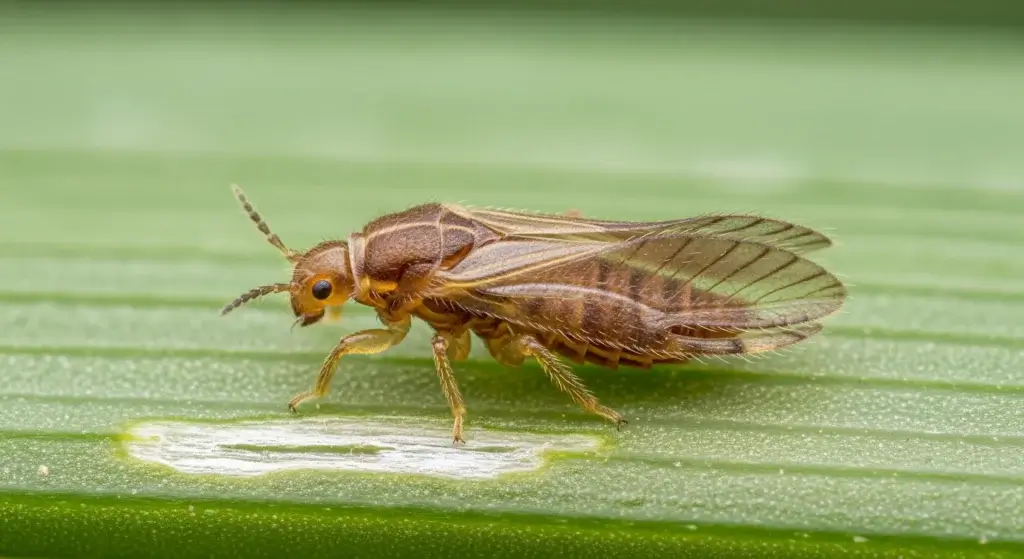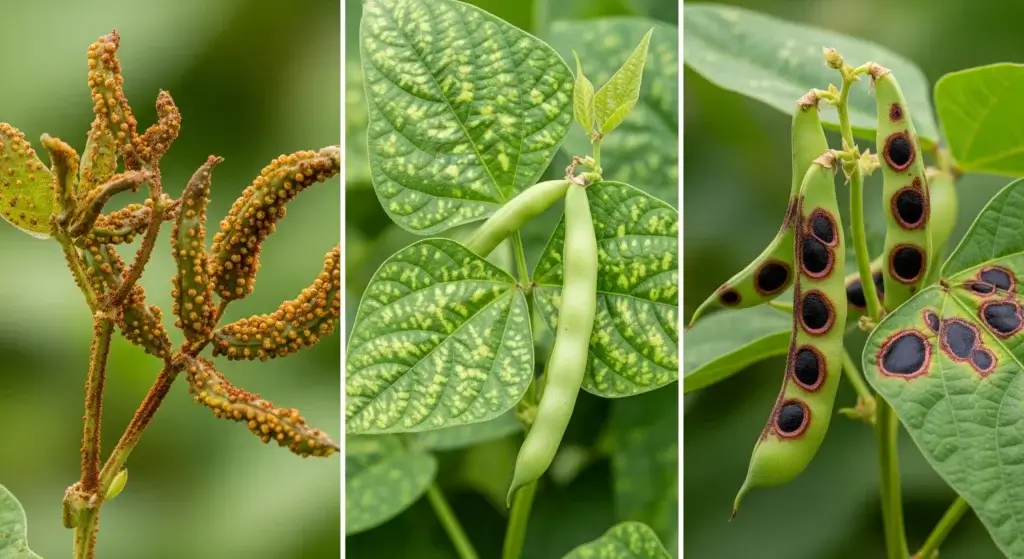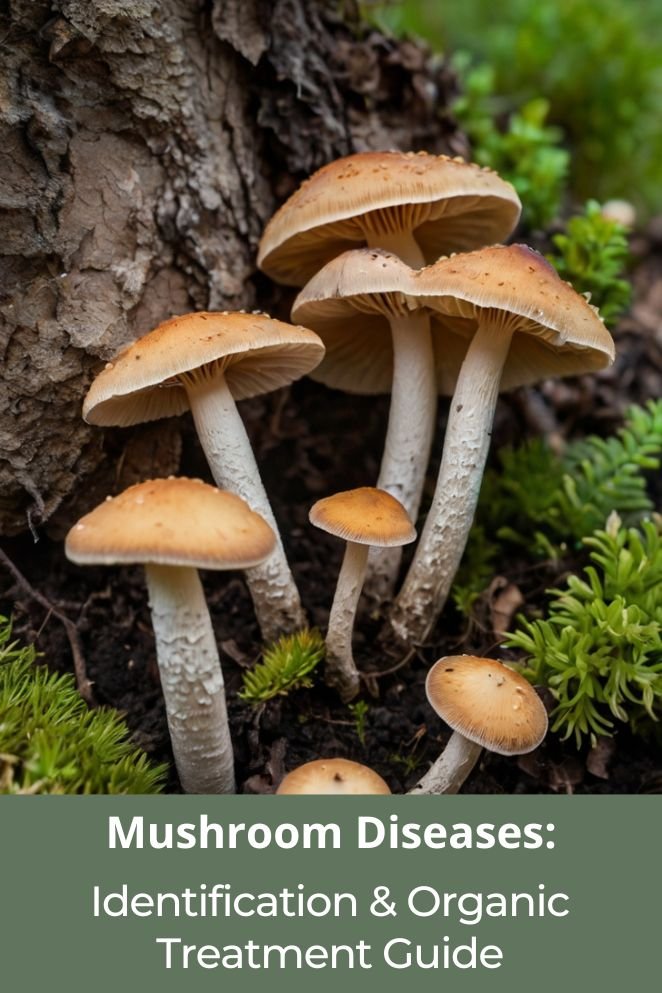
Growing mushrooms is hot right now—everyone from backyard growers to full-blown farms is in on it.
But here’s the deal: fungal diseases are like the villains in a mushroom action movie.
Dry bubble, cobweb, wet bubble, green mold—these guys can wipe out your crop faster than you can say “shiitake.”
If you want your harvest to survive the season (and not turn into a spore horror show), you’ve gotta learn to spot these diseases early and fight them off—organically.
No chemical sprays, no drama.
This guide’s your toolkit for ID’ing the usual suspects and dealing with them the clean, green way.
Think of it as mushroom self-defense—with less kung fu, more compost.
The Top 5 Mushroom Diseases Every Grower Must Know
Let’s be real—mushroom growing is cool until the diseases show up like uninvited guests at a dinner party.
Here’s your quick survival guide to the top troublemakers and how to shut them down organically.
- Read also: A Complete Guide: How to Start a DIY Mushroom Garden at Home
- Read also: Best Conditions for Mushroom Growth: A Beginner’s Guide
1. Green Mold (Trichoderma spp.)
The Thanos of mushroom diseases. Starts white, turns Hulk green.
If you catch it early, you’ve got a 50/50 shot.
Spot it:
- Starts white and fluffy
- Turns bright green fast
- Smells funky
- Grows faster than your actual mushrooms
Fight it:
- Sprinkle table salt on it (seriously)
- Spray with baking soda + water (1:10 ratio)
- Dunk in 60°C water for 30 mins (during spawn)
- Soak in alkaline water for a day and a half
2. Dry bubble disease (Lecanicillium fungicola)
Especially brutal for button mushrooms.
Think of it as the weird puffball cousin nobody invited.
Spot it:
- Misshapen caps
- Gray fuzz
- Bubbles that look like sad balloon animals
Fight it:
- Yank infected shrooms (gently!)
- Boost airflow to lower humidity
- Use Bacillus species as biological backup
- Make sure your substrate is clean and properly pasteurized
3. Wet bubble disease (Mycogone perniciosa)
If your mushrooms look like they’re melting into goo, you’re probably dealing with this guy.
Spot it:
- Mushrooms turn mushy and smell bad
- Wet brown/black patches
- Total collapse—RIP, fungi
Fight it:
- Improve drainage
- Use diluted organic copper sulfate
- Add good bacteria to outcompete the bad guys
- Lower humidity and get air moving
4. Cobweb disease (Cladobotryum spp.)
Looks harmless at first. Then it spreads like it’s auditioning for Stranger Things.
Spot it:
- White web over mushrooms
- Spreads fast, turns gray
- Mushrooms get soft and gross
Fight it:
- Salt it like you’re seasoning fries
- Spray with 3% hydrogen peroxide
- Carefully remove infected areas
- Clean everything between harvests
5. Bacterial diseases (Various Bacillus spp.)
Not a fungus, but just as nasty. Smells bad, feels worse.
Spot it:
- Slimy caps
- Brown/black spots
- Rot and foul odor
Fight it:
- Soak grains 12–24 hrs before sterilizing (wakes up spores so you can kill them)
- Keep pH slightly alkaline
- Clean everything, always
- Use beneficial bacteria to block the nasty stuff
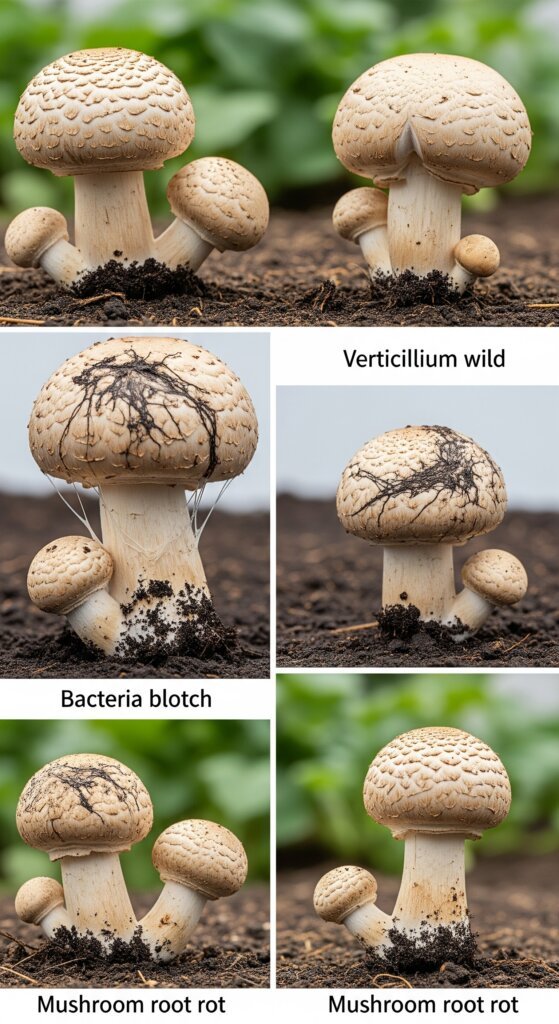
Integrated Organic Disease Management Strategy
The best way to fight mushroom diseases? Don’t let them move in to begin with.
Here’s a no-fluff, grower-to-grower breakdown of how to keep your setup clean, healthy, and fungus-drama-free.
Step 1: Prevent it like a pro
1. Nail your substrate prep
- This is where most problems start—don’t half-bake it.
- Use composted, pasteurized substrate. No shortcuts.
- Keep it clean during inoculation. Sterile = sexy.
- Check your pH (you want it between 6.5–7.5). If it’s off, adjust it. Mushrooms are picky like that.
2. Lock down the environment
- Think of this as setting the mood for mushrooms, not mold.
- Keep temps comfy: 55–75°F for most species.
- Humidity = 80–95% when fruiting (yes, mushrooms are divas).
- Airflow? Yes. Drafty wind tunnel? No.
- Got a HEPA filter? Use it. You’re not breathing gym air here.
3. Sanitation
- Cleanliness is not optional.
- Wipe down all tools and surfaces before and after.
- Wear clean clothes. Yes, even if it’s just you and your shiitakes.
- Foot baths + hand wash stations = clutch.
- If anything looks infected, yeet it. Don’t wait. Don’t think. Just toss it responsibly.
Step 2: Catch it before it spreads
Daily mushroom check-in:
- Grab your coffee and do the rounds like a boss.
- Look for anything weird. Colors. Textures. That one spot that’s giving you side-eye.
- Smell check: if it’s funky and not in a good way, something’s up.
- Are your shrooms growing like usual?
- Double-check temp, humidity, airflow.
- Jot down the weird stuff—even if it’s minor. Future-you will thank you.
Weekly deep dive:
- Think of this as your Sunday spa day for the grow room.
- Peek inside that substrate. Any odd colors or textures?
- Make sure all your gadgets are still doing their job.
- Clean your filters. Seriously.
- Do a full-on sanitation sweep.
Step 3: Organic Treatments Without the Panic
So a disease still snuck in? No shame. Time to handle it like a grow-room Jedi.
Step 1: Isolate the problem
Quarantine the affected area faster than you mute spam calls. Document what you see (photos = bonus points).
Step 2: Pick your weapon
Go organic and go gentle at first—like neem oil, baking soda sprays, or garlic-based fungicides. If that doesn’t work, you can level up.
Step 3: Tweak the environment
Adjust airflow, lower humidity, bump the temp—do what it takes to make the space less comfy for pathogens but still chill for your mushrooms.
Step 4: Watch like a hawk
Track what works and what doesn’t. Keep notes. Learn. Evolve. Grow better next time. Boom—you’re not just growing mushrooms, you’re building wisdom.
Advanced Organic Solutions and Biological Controls
Alright, you’ve cleaned like a germaphobe, dialed in the environment like a mad scientist, and you’re still getting hit with some funk? No worries.
You’ve got backup.
Beneficial microorganisms
Trichoderma species for good
Not all Trichoderma are troublemakers.
Some strains are your mushroom’s BFFs, blocking nasty diseases and even helping your mushrooms soak up nutrients better.
Just make sure you pick the right strain—like choosing the good guys in a Marvel movie.
Bacillus-based biocontrols
Certain Bacillus bacteria don’t mess around.
They kick out the bad mushroom pathogens like a bouncer at a club.
Add them to your substrate early, and they’ll keep your grow safe and sound.
Pseudomonas applications
Some Pseudomonas strains pump out antifungal compounds that quietly shut down disease without stressing your mushrooms.
It’s like having ninja protectors in your grow room.
Natural antifungal compounds
Essential Oil Treatments
- Tea tree oil (diluted 1:100) — perfect for cleaning surfaces like a spa day for your grow room.
- Oregano oil — great for treating the substrate, giving pathogens a taste of their own medicine.
- Thyme oil — a natural fungicide, basically the garlic to vampire diseases.
Plant-Based Extracts
- Neem oil — the all-rounder pest and disease manager your mushrooms will thank you for.
- Garlic extract — not just for cooking; it’s a bacterial nemesis too.
- Cinnamon oil — antifungal power with a spicy twist.
pH Manipulation Strategies
Pathogens hate it when things get a little less cozy.
Most mushroom diseases prefer neutral to slightly acidic spots.
So if you nudge your substrate’s pH up to around 7.5–8.0, you create an environment that’s basically a fungal “No Vacancy” sign for the bad guys — all while keeping your mushrooms comfy.
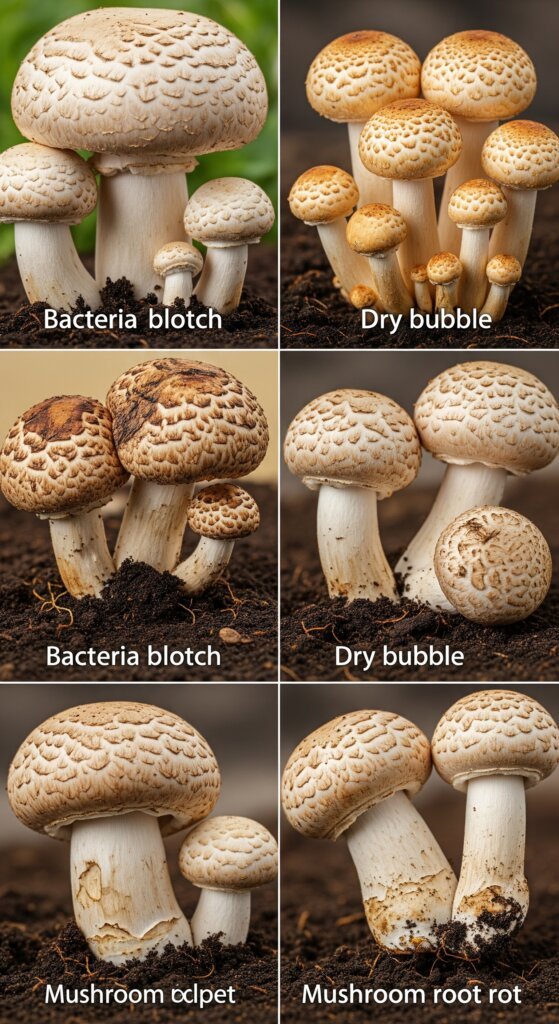
Building Long-Term Disease Resistance
Alright, friend—if you want your mushroom farm to stay strong and healthy for the long haul, you gotta think bigger than just today’s crop.
Here’s how to build a fortress against disease that lasts.
Crop rotation and substrate diversity
Disease loves to set up camp when you plant the same mushroom on the same substrate over and over. Switch it up!
Rotate different mushroom species and substrates to mess with the disease cycle.
Think of it like switching lanes in traffic to avoid the jam—keeps everything flowing smoothly.
Genetic diversity in cultivation
Relying on just one mushroom strain?
That’s like putting all your eggs in one basket… and we all know how that ends.
Use a mix of strains—some naturally tougher against diseases.
It’s like having a superhero squad with different powers instead of just one guy in a cape.
Integrated farm management
Companion growing
Plant some good neighbors!
Growing beneficial plants near your mushrooms can kick pests and diseases to the curb by creating a natural defense squad.
It’s like having friendly neighbors who keep an eye out for trouble.
Waste stream management
Don’t let old substrate trash pile up and turn into a pathogen party zone.
Properly handle and compost spent substrates so you’re not feeding future problems.
Think of it as cleaning your room—nobody wants to live in a mess.
Seasonal Disease Management Considerations
Listen up—each season brings its own set of curveballs for your mushrooms.
Knowing what’s coming lets you dodge disease like a champ all year round.
Spring
Humidity spikes and wild temperature swings make diseases throw a party.
Step up your monitoring game and keep your environment tight.
Think of it like babysitting—you gotta watch those mushrooms closely or things get messy fast.
Summer
High temps stress your fungi out, making them weaker against bugs and diseases.
Keep things cool with fans, good airflow, and maybe some shade.
Your mushrooms hate feeling like they’re stuck in a sauna.
Fall
As the weather changes, your grow setup needs a tune-up.
Switch up your parameters and double down on disease prevention.
It’s like wardrobe change day—time to swap the shorts for sweaters and prep your shrooms for cooler nights.
Winter
Heating up means closing off vents, but hold up—less airflow can invite diseases to crash your party.
Find the sweet spot between keeping things cozy and letting fresh air in.
Think of it as Goldilocks ventilation—not too hot, not too cold, just right.
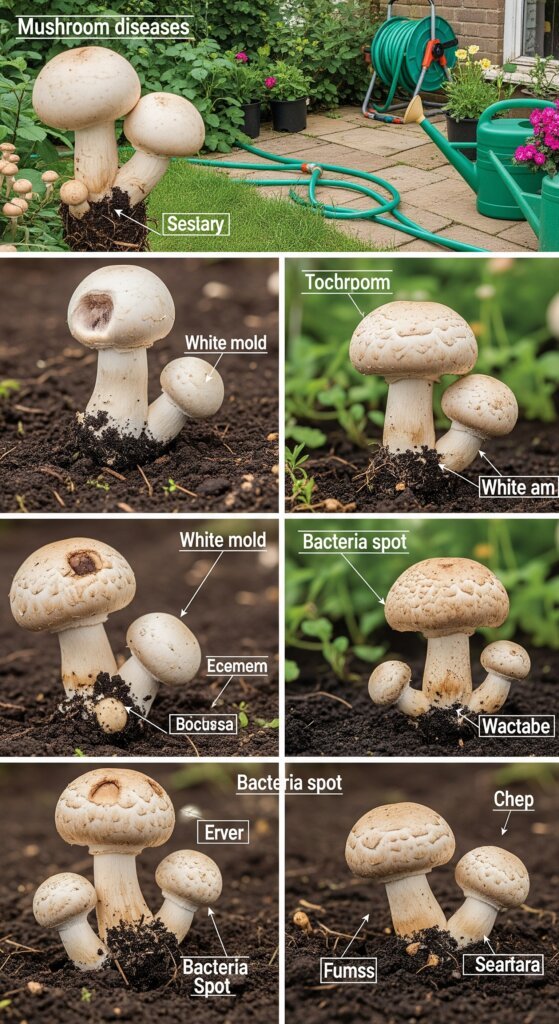
- Read also: 7 Common Mushroom Pests & How to Stop Them Naturally
- Read also: Mushroom Care Calendar: What You Should Do Each Season
Conclusion: Your Path to Healthy Mushroom Cultivation
Look, managing mushroom diseases organically isn’t a one-and-done deal—it’s a steady hustle.
Keep your eyes peeled, catch issues early, and hit them with the right treatments fast.
Stick to the tips here—spot problems, use organic fixes, rotate wisely—and you’ll keep your mushrooms thriving without any chemical drama.
Consistency is your secret sauce.
The payoff? Cleaner crops, happier planet, and customers who’ll love your sustainable mushrooms like they’re the next big thing (because they are).
Start today, keep at it, and watch your mushroom game level up. Your fungi—and your future self—will thank you.


